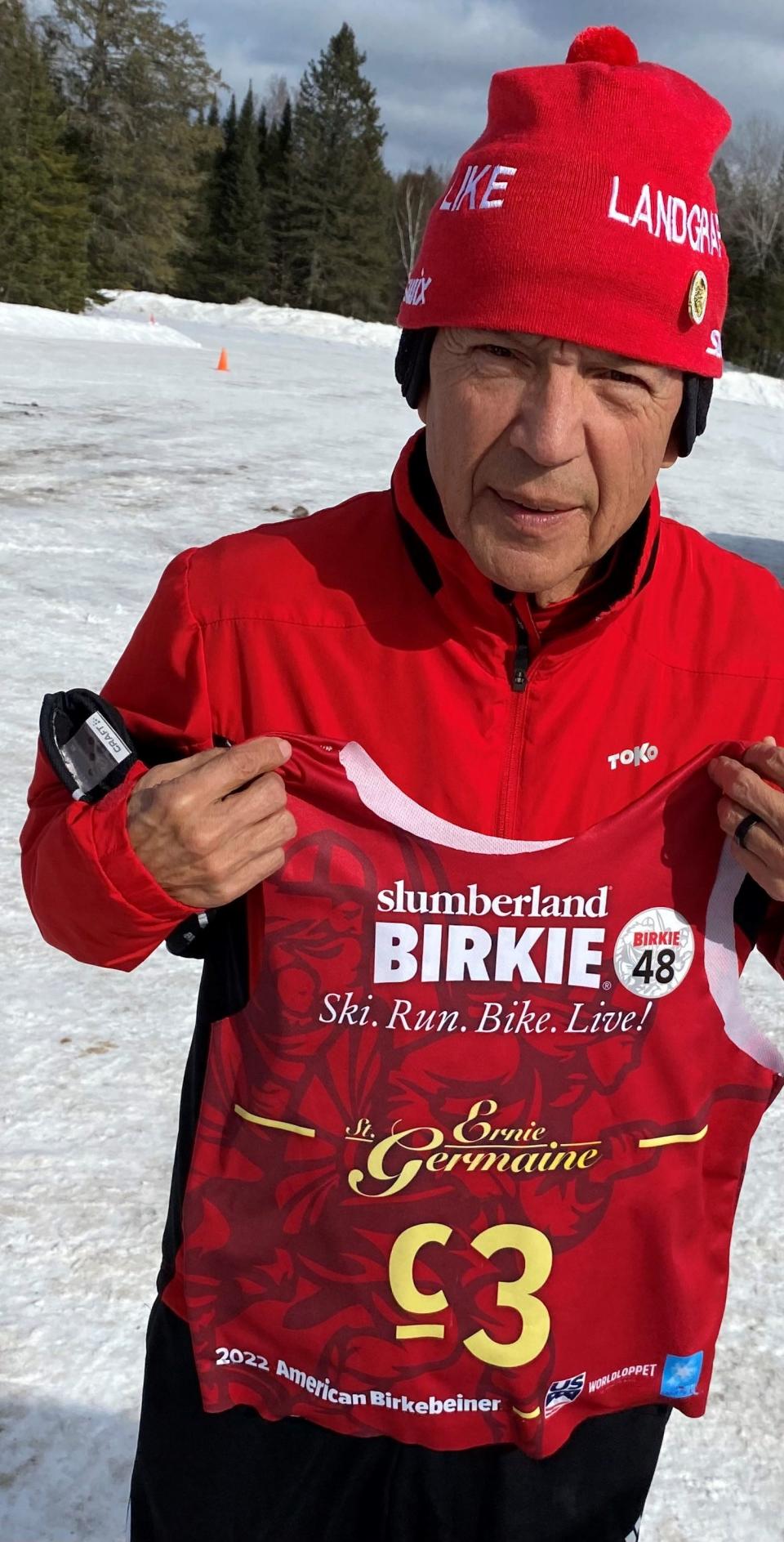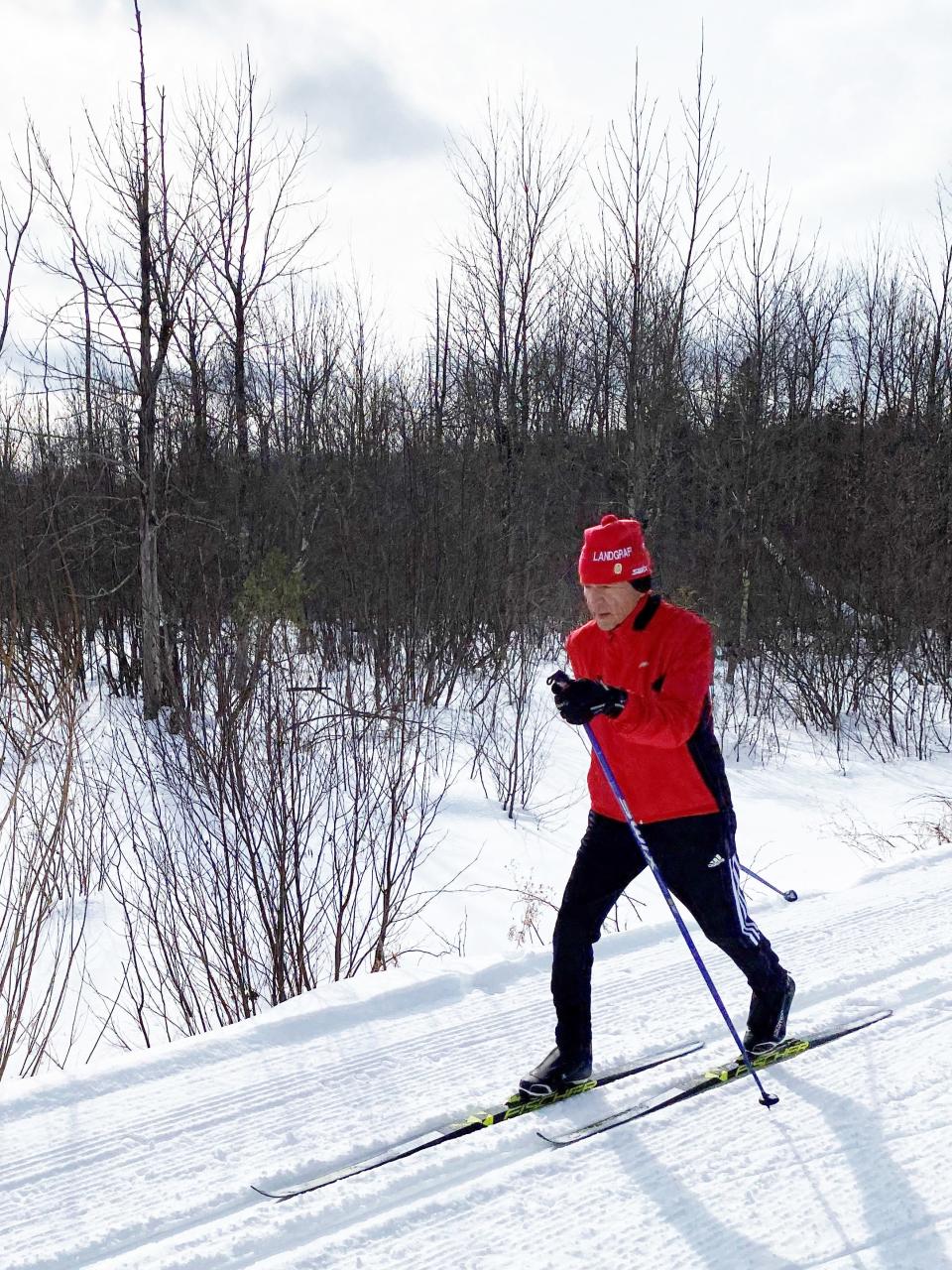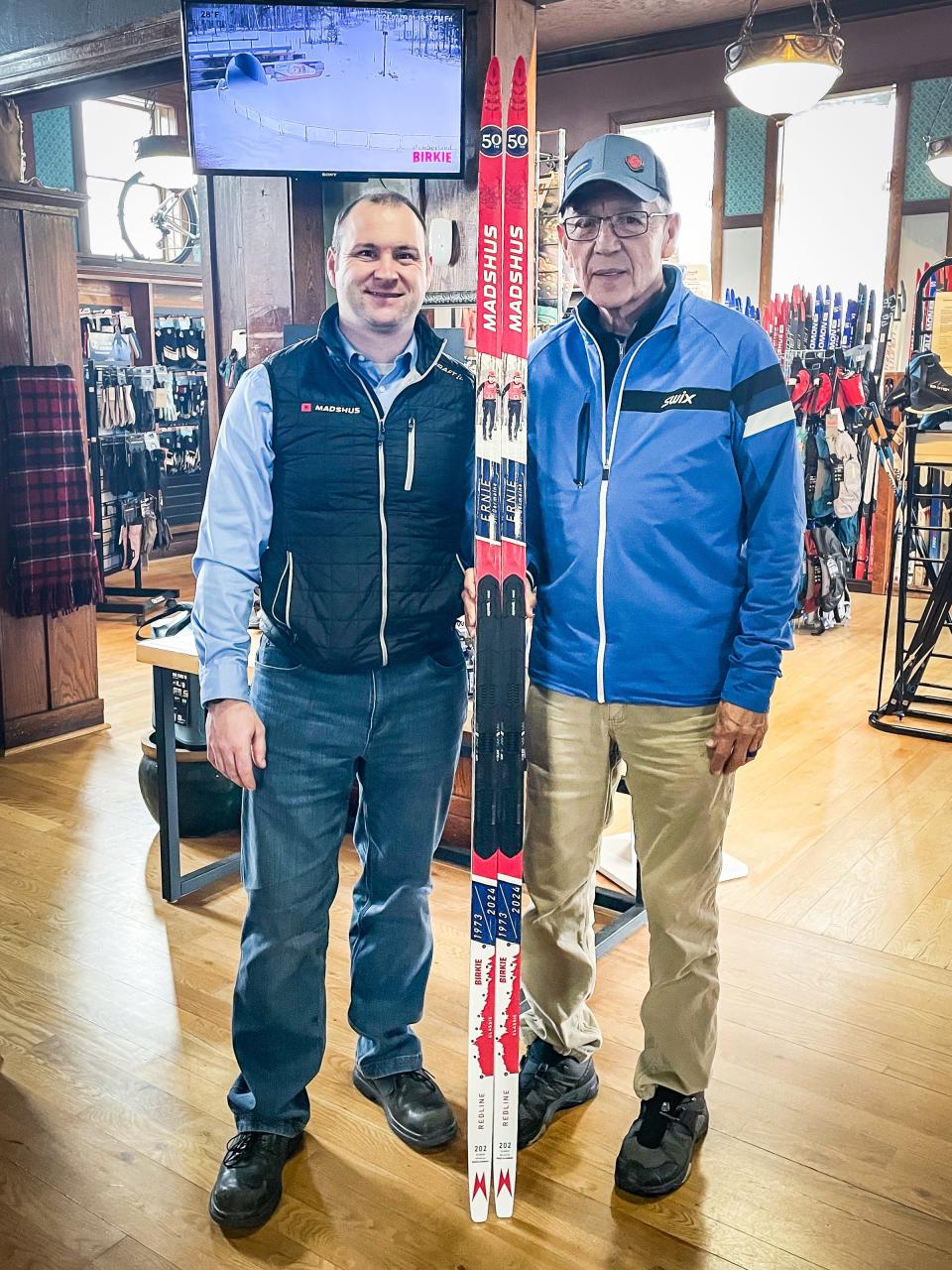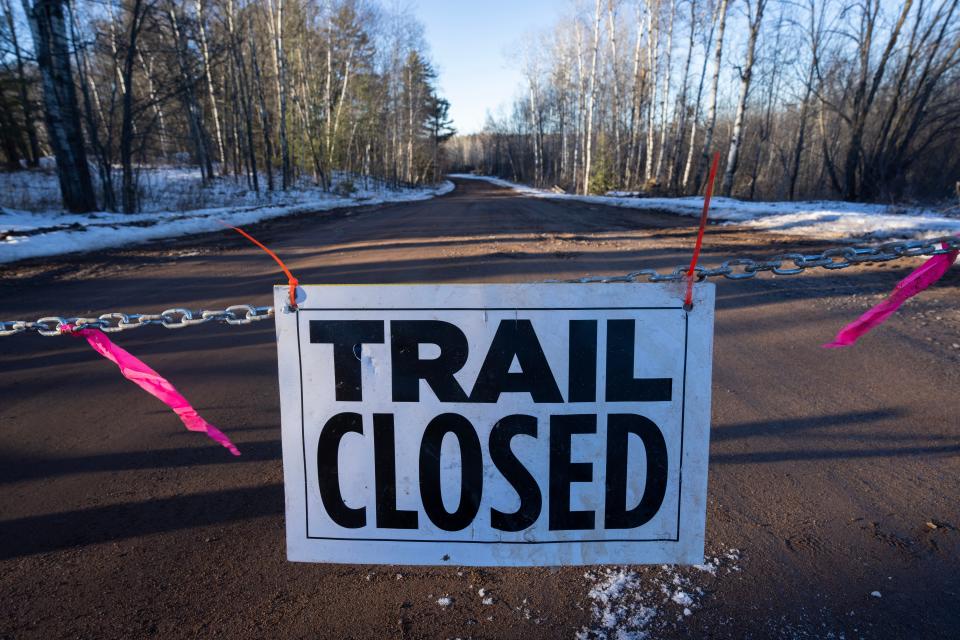From pancakes to a clown in polka dots, ski legend Ernie St. Germaine has 50 years of Birkebeiner stories
Fifteen minutes with Ernie St. Germaine turns into a glorious hour as he relives five-decades-old memories in vivid detail.
There’s no need to interrupt or ask questions. No point, really.
Talking cross country skiing, of all things, the energetic 76-year-old commands the attention of his audience of one with tales of how blueberry pancakes led to him learning to ski. Of how he was drafted into the first American Birkebeiner, vowed to quit and then got sucked into the second. Of the clown who nearly ended his streak. Of preparing for a bittersweet, record-extending 50th with no snow in the Wisconsin Northwoods.
As the Birkie evolved from 35 people racing from Hayward to Cable to an international gathering of more than 10,000 headed the other direction, St. Germaine has been the one constant.
Next week he will clip boots into bindings and set off on his 50th Birkebeiner as the only skier to participate in every one.
Then he’ll have another story to tell.
More: What to know about the American Birkebeiner

Ernie St. Germaine didn’t set out to race one Birkebeiner, much less 50
The American Birkebeiner started in 1973 as another project from Hayward businessman Tony Wise, who named the event in honor of a similar marathon race in Norway, and was coaxed by friends of Norwegian descent. The marathon would run from the Lumberjack Bowl in Hayward, site of the Lumberjack World Championships he launched in 1960, to the new lodge at the Telemark alpine ski area he had founded in 1947 outside Cable.
St. Germaine knew Wise and he had a grandfather who knew some of those Norwegian friends of Wise’s.
“My grandpa knew Lyman Williamson because Lyman Williamson had a lumber mill in Hayward right out by the airport, on the river,” St. Germaine said.
That relationship was more than transactional, though.
“One Friday night, Lyman called me and told me to come over the next morning to his house,” St. Germaine said. “So I went over there Saturday morning, and Lyman’s wife, Edna, was cooking pancakes. Oh, I loved her pancakes. Blueberry pancakes. So she gave me some.
“And Lyman was sitting at the counter by me, we’re eating pancakes and he says, ‘Tony’s havin’ a race.’ And, see, Tony had races – alpine races every weekend – and I thought, oh, yeah. And Lyman said, ‘I want to do his race,’ and Edna’s over there with her back to us, cooking at the stove. And she said, ‘Lyman! You are not going to ski that race.’
“He looks at me and he kinda grins and he says, well, we talked him into doing a race. He says, ‘Good thing. It’s important.’ And she said, ‘Lyman, you are 72 years old. You are not going to ski that race!’ He grinned at me and said, ‘So, my boy, you are going to have to represent me.’
“And I said sure. He said, ‘Well, I better show you first.’”
St. Germaine had skied. He knew Wise and he knew Telemark. In fact, he took carloads of Native American kids from the Lac Courte Oreilles reservation in the Hayward area with him when he would go to alpine ski, which endeared him to Wise.
But when he finished his pancakes and Williamson showed him a pair of long, narrow skis, bamboo poles and “boots” that were leather shoes attached only at the toe, and then took him to the driveway, he didn’t know what to think.
“In alpine skiing, in order to get from Point A to Point B on the flat, you skate,” St. Germaine said. “So I started to skate over to where it goes up the hill, and oh, he yelled at me: ‘No, no, no, you damn fool. No skate! You never skate. You gliiiiiide.’
“So I started gliding. ‘Now up the hill.’ And I went up the hill and turned around and came skiing back down, stand-turned right in front of him and said, ‘nothing to it.’ He said, ‘My boy, you better practice for a while.’ So I might have practiced 20 minutes, half hour, going up and down, back and forth, to the mailbox and back. Took them off, came in the house and said, there’s nothing to it.
“He kind of laughed. He says, ‘You be here next Saturday morning at 8 o’clock, and Edna will fill you up with pancakes again.’”
‘Where do we go?’ The story of Ernie St. Germaine’s first Birkie
St. Germaine was an athlete and still is.
In the week that followed, he convinced lifelong friend Dave Landgraf to join him. A physical education teacher, Landgraf also was in good shape, and he’d thought he’d heard something about the new race. He was game, if woefully naïve.
“We both got bibs, and there’s a start banner stretched across the bowl, and there’s a group of people on the deck at the pancake house and there’s a small group of skiers,” St. Germaine said. They went to the far end of the line, oblivious but eager as 25-year-olds can be.
“Lyman, I saw him come down and kneel down. He was taking a picture. And I yelled at him, ‘Lymannnnn! Where do we go?’ And he yelled back and he said, ‘Don’t worry. I’ll pick you up at Telemark.’
“Both of us were standing there and I had my head down and Dave says to me, ‘What did he say?’ and the cannon went off.”
Four and a half hours and 48 kilometers later – 30 miles of wooded hills and open fields, following a single snowmobile track – the answer was clear.
“We made it to Telemark, and we finished together and we crashed across the finish line together in a heap,” St. Germaine said. “We had to come skiing down that to the finish line to a card table at the bottom of the hill in front of the deck of the chalet. And there were Alpine skiers up there, cheering us. There were only a handful of them. And that was it.
“I’m lying there in a heap, exhausted. We both got up and were laughing. And I just swore up and down, boy, this was dumb, I’ll never do this again.”
The day, though, wasn’t over. St. Germaine rehydrated at the chalet – Edna ordered him glass upon glass of milk – and then went back to the Williamsons’ home where he promptly fell asleep on the couch.
“(About) 6 o’clock, Lyman comes over and shakes me on the shoulder and I looked up at him and he says, ‘C’mon, my boy,’” St. Germaine said. “‘We got to get back up to Telemark for the awards, the banquet.’
“I looked back up at him and I said, ‘Lyman, you’re going to have to represent me.’ Then I fell asleep.”
‘We just kept going’: How one Birkie turned to two, then three …
It was Wednesday before St. Germaine could walk normally again. His shoulders ached from muscling up the hills, and the balls of his feet ached immeasurably from all the bending, pushing and gliding. He crawled to the bathroom or walked on his heels, cursing himself with every step.
“I absolutely swore I would never, ever, again do anything that stupid,” he said. “Ever again.”
The vow lasted, too, for about 50 weeks.
St. Germaine had earned his degree in education and was coaching baseball at UW-Stout when an old friend leaned on him for help. The Nordic program Wise had begun at Telemark was taking off, and would St. Germaine – with his limited experience – help teach in the winter?
OK, maybe that wasn’t really a question. St. Germaine never said no to Wise.
“About two weeks before the race – and it was coming, there was advertising and I knew about it – Tony came by me in the chalet, he looked at me and he says, ‘I’m going to need ski patrol for the race this year,’” St. Germaine said. “He says, ‘You’ll wear a backpack and you’ll be my ski patrol.’ … I thought, OK, I’ll wear a backpack with first aid.
“He was teasing, of course. Just making sure I was going to do it again. I called up Dave and said, we’re doing it again. So he and I were there Year 2. Then again in Year 3. Then by that time it was kind of becoming a habit and we just kept going.”
A 103 fever and a clown in polka dots nearly derailed Ernie St. Germaine
Over the decades, the Birkebeiner has changed.
American Bill Koch’s silver medal in the 1976 Olympics helped spark a boom in cross country skiing in the United States. Wise connected his Hayward-to-Cable race with other elite long-distance cross country ski events in the international Worldloppet series. Then he changed its direction and later lost the Birkie as part of Telemark’s bankruptcy. The classic technique – parallel strides akin to walking or running – was eclipsed by a skating style of skiing that proved faster.
This year’s main race has attracted more 10,000 skiers from all 50 states and 26 countries, plus thousands more planning to ski in other events earlier in the week. Some will drop out, given the far-from-ideal conditions that have forced organizers to cut the distance from 53 kilometers for classic-style skiers and 50k for freestylers.
That’s happened before. The Birkebeiner was canceled in 2000 and ’17, was shortened a handful of times and even went virtual in 2021 due to the COVID-19 pandemic.
Through it all, St. Germaine has completed the distance each time – always classic style – albeit with a few close calls.
“One year, I started and I was sick, 103 temperature at the start. I was so sick,” St. Germaine said. “And at the end of the race, my temperature was 96. I wasn’t sick anymore. I was just fine after that, wasn’t sick. No after effects, no lingering effects from being that sick. The Birkie healed me.”
That’s a cure not everyone would try.
“Another one, we were skiing north and on a downhill – classic – and we’re going along and a guy in a polka dot clown suit had shortie skis – there was a fad where they started wearing shortie skis; they thought it was easier to skate with – came skating through the middle of us and skated across my skis and took me out and the guy behind me and I dislocated my shoulder,” St. Germaine continued.
“I know how to treat that. I put it back in myself. I knew what to do. There was a sapling there, and I popped it back in. That was at about the 18k point. So we had a long way to go to the finish up at Telemark. I skied one-armed for the rest of the race.”

‘Nobody ever taught me how to quit’
St. Germaine can’t tell you his best time or his best finish from his 49 Birkies and wouldn’t begin to try to guess. He has never been close to placing – especially as the race attracted more elite competitors – but that’s never been his reason for entering.
“I love to ski,” he said. “Of all the things that I’ve done and being an athlete all my life, a baseball player … instructors and coaches, nobody ever taught me how to quit.”
St. Germaine doesn’t judge those who do. Every skier has goals of their own. Some misjudge the difficulty of the course, fall ill or just have a bad day.
“There was a girl that was going up O’Brien Hill, which is a 1k long hill, 7k from the finish,” St. Germaine said. “She had fallen down, and I stopped by her. She was getting up slowly. I started singing to her, ‘You Are So Beautiful.’ And everybody around joined me and started singing to her. And she got up, smiling, and skied with us. It was wonderful.
“Another time, I came up, going up a hill, and there was a guy stopped, completely cold, and he was leaning on his poles. ... I say, ‘You’ve got 11k to go. You just came up one of the toughest hills, and here you are almost to the top.’
“He says, ‘I don’t think I can make it.’ And I said, ‘You know, Main Street is the most amazing experience.’ I said, ‘There’s nothing like it. People screaming and cheering for you. You will never forget it as long as you live.’ And he started skiing. And he just kept going. Before long, he gathered himself again and there he goes, he skied away from me. That made me so happy. I just know he made it to Main Street and that finish line.”

Art that left him speechless
St. Germaine, who lives in Lac du Flambeau and is moving back to Hayward in the spring, visited Main Street last week.
The race won’t finish on the snow-covered thoroughfare this year because there’s no snow to cover it. But he likes to visit with the folks at Riverbrook Bike and Ski – co-owners Tim Swift and Cindy Smith-Kaner and the athletes who come and go – where he has been a friend and customer for decades.
So Feb. 9 was one of those social stops, he thought, but it turned out to be so much more.
Almost since the 2023 Birkebeiner, they’d been talking about getting St. Germaine a pair of skis to commemorate his 50th and likely final race. He didn’t need new ones, but this pair from Madshus, a 118-year-old manufacturer with roots in Norway, would be special.
“(Swift) said, ‘Yeah, I’ve been talking to the rep and I talked to him about who you are and how important this event is and the history and your participation, and he got interested,’” St. Germaine said.
“And then about in August they measured me and weight and the whole works. They want to make sure they have the right skis for you. Classic skis, of course. Classic technique. I’m just thinking, oh, maybe a pair of skis and it’ll be great.”
St. Germaine put it in the back of his mind until the first snowfall, around Halloween. He checked with Swift, who had no skis for him but promised to check. December … same thing. January … nothing.
“I stopped in there one day and they were acting embarrassed: ‘Gosh, no, we haven’t heard. Sorry, Ernie, but as soon as they come in,’ he says, ‘I’ll call them on Monday again and see where they are, if we can get you a pair or not.’”
The whole time, though, the shop had been working with American Birkebeiner Ski Foundation executive director Ben Popp, Madshus representative Ben Dubay and the company in Europe on a pair of red, white and blue skis each with the 50th anniversary logo, the years 1973 and 2024, a representation of the traditional course and St. Germaine’s name and photo.
On his visit, they surprised him.
“I came in and I was kind of in shock,” St. Germaine said. He was speechless. “There’s Ben Dubay standing there. Tim is at that level of skier, and Cindy, too. These guys are really good skiers.
“You know, who am I? I’m just a skier. I haven’t won a race. Awards. Nothing. I just ski.”
The skis belong in a display case, St. Germaine said, but with all the trouble his friends went through to give him such a gift, they need to be in the Birkie, too.

But then Ernie St. Germaine almost said no to the Birkebeiner
The Birkebeiner underwent another change in 2022, when the full-length races for skate-style and classic skiers, and the half-length Kortelopet were spread over three days rather than run simultaneously.
As part of that, one option for skiers became an “open track” version of the race on Wednesday, three days before the main event, during which entrants more interested in the accomplishment of completing the Birke than the competition can start during a one-hour window and ski at their own pace. That’s the option St. Germaine has chosen.
With no real opportunity to train on snow this year, St. Germaine has stayed fit by hiking and biking, but the weather and the likelihood for treacherous trail conditions was keeping him up nights. Organizers announced Monday that race distances have been cut for all but the elite skiers and will be run as multiple laps on a shorter loop rather than point-to-point.
“They’ve stockpiled a lot of snow by building mounds, and they’re going to spread that out,” he said.
That manmade snow, though, will quickly turn slick.
“And I was thinking a thousand skiers on a 10k loop crashing and snowplowing …” St. Germaine continued. “I went in to talk to Ben just to tell him I’m not going to do it.”
In deference to a man who’s meant so much to the event for 49 races and was about to forgo his 50th, Popp offered an alternative.
“‘The elites are going to be here, they’re going to be here practicing on it,’” St. Germaine said Popp told him. “‘On Tuesday morning, they have a practice session from 6 in the morning until 10. From 10 o’clock Tuesday, the course is yours.’
“… That’s my 50th Birkie.”
St. Germaine will have a little company that day, both in body and spirit.
Remember Dave Landgraf, the boyhood friend who joined St. Germaine in the first American Birkebeiner? He died in 2011 after being struck by a motorist while riding his bicycle along a state highway south of Hayward. A couple of years before that, though, St. Germaine and Landgraf were asked in a television interview how long they planned to keep skiing the Birkie.
“Dave looked at me and said, ‘Ernie, boy, let’s do 50 and see how we feel.’ And so I’ve always had that in my head,” St. Germaine said.
“When he was killed on his bike and we let him go, his wife gave me some of his ashes. She said, do what you want with them. So I have been.
“Everywhere I go and everything I do, when I ride my bike and when I walk and hike and pole hike and when I ski, he’s with me. I have him in my backpack. Every Birkebeiner, Dave has skied with me. So Dave will do his 50th too.”
This article originally appeared on Milwaukee Journal Sentinel: Wisconsin ski icon Ernie St. Germaine's 50 years of Birkebeiner tales

